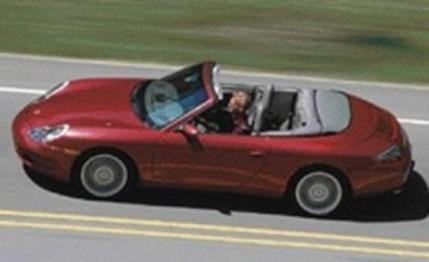
 First Drive Review
First Drive Review
Don't confuse Porsche engineers with those pocket-protector-wearing, slide-rule stereotypes. These guys know how to party. Check out the stuff a Porsche engineer unloaded during the recent introduction of the revamped, 2002 911 Carrera:
Porsche in 1997 discarded wheel studs and lug nuts and opted for bolts to secure wheels to hubs. Pressing the studs into the axle stubs deformed the hub face enough to induce brake shudder in a few cars. But installing wheels with bolts is a tough process because you have to hold the wheel in position to line up the holes. To make wheel mounting easier, all Porsches now come with a long rod that you secure to the hub first and hang the tire on it so it's easier to insert the bolts.
Here's another: Those cross-drilled rotors look way cool, and the holes reduce brake fade by keeping the rotors up to 30 degrees cooler.
Unless you're of the pocket-protector brethren, we apologize for the above mind-numbing details. We do have a point, though: Those guys at the Weissach engineering shop don't simply sweat the details, they flood 'em. For this midyear model change, they also pounced on the 996 version of the 911 and gave it a thorough makeover.
Let's start with the engine. It's still a flat-six, but now, thanks to numerous additions, it pumps out 315 horsepower at 6800 rpm - 15 more horses than the 2001 car. Eighty percent of the engine internals were changed to find the new power, and the flat-six retains LEV status and current fuel economy.
A stroke 4.8mm longer means new connecting rods and crankshaft, which now pull the pistons an additional 0.19 inch farther down the cylinder. Engine displacement is up 209 cubic centimeters to 3596 (3.6 liters).
Also new is a fuel-supply system with no return line, which keeps the fuel cooler. There's also a new exhaust system with reduced back pressure and a throatier low-rpm burble that anyone with a trace of 93 octane in his or her veins will find luscious.
Complementing the deeper-breathing motor is the latest version of VarioCam Plus. It combines the two-stage cam-lobe switching system first seen on the 2001 911 Turbo with the variable cam-phasing system used on the previous 911. This latest 911 cam varies the intake-cam timing continuously over a 40-degree range. VarioCam Plus allows the engine to operate with optimal cam timing and lift over a broader rev range. It provides both low-end torque and high-rpm power. Porsche says, in fact, that although peak torque is up 15 pound-feet to 273 at 4250 rpm, there's more torque across the band, thanks also to the greater displacement.